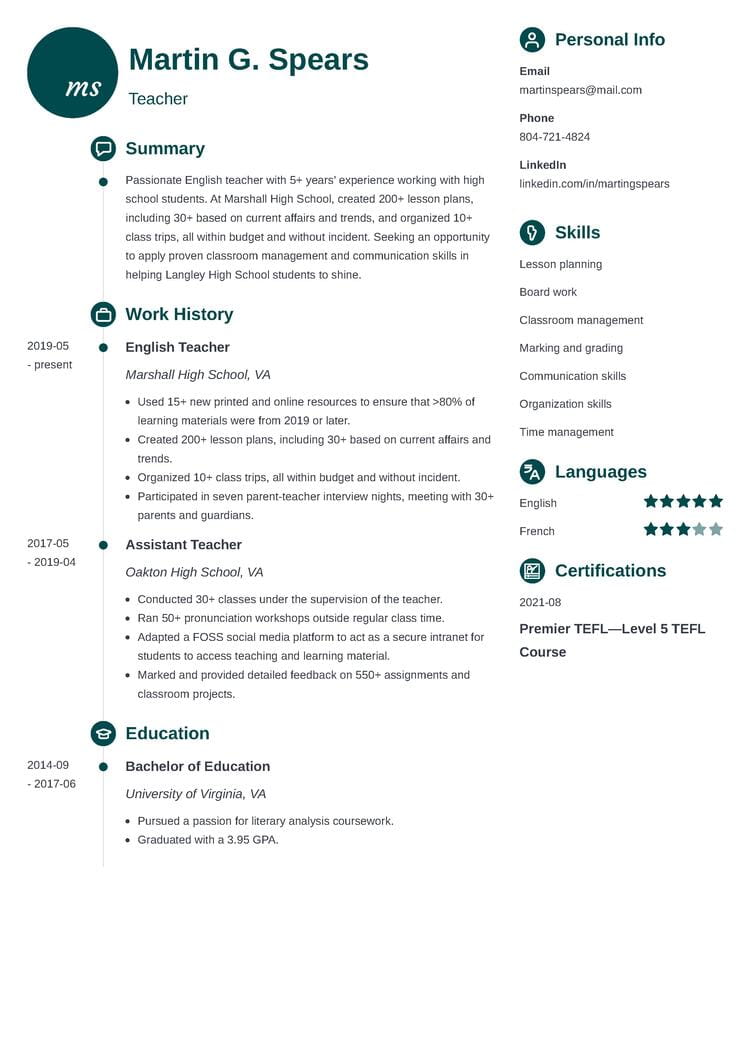
Career Change Resume Examples for 2026 (+Templates & Tips)
You're about to change your career. Learn how to write a career change resume that will get you the dream job.

Tom Gerencer
Career Expert
Writing a resume can be challenging in many ways. You may, for example, struggle to fit all your experience, knowledge, and skills into one page. With resume bullet points, you can structure and organize key resume data neatly and deftly. But do you know how to make them impactful?
Resume bullets aren’t just to be plain sentences. Learn how to make the best use of these simple yet powerful symbols.
In this guide:
Save hours of work and get a job-winning resume like this. Try our resume builder with 20+ resume templates and create your resume now.

What users say about ResumeLab:
I had an interview yesterday and the first thing they said on the phone was: “Wow! I love your resume.”
Patrick
I love the variety of templates. Good job guys, keep up the good work!
Dylan
My previous resume was really weak and I used to spend hours adjusting it in Word. Now, I can introduce any changes within minutes. Absolutely wonderful!
George
Looking for other tips on resume writing? Check the articles below:
Now, find out why and how to use resume bullet points the right way:
Resume bullets are inevitable when creating an application that aims to be clear and readable. They help you organize all the information in the right order and without occupying too much of the resume’s space.
What’s more, resume bullet points emphasize the facts on your work timeline that require particular focus. Thanks to them, such highlights are well-noticeable and remembered better.
Whether you’re writing a chronological or functional resume, resume bullets rise to the challenge. Plus, they can be used in many resume sections that we will feature later in the article.
The work experience section is where the resume bullet points come in the handiest. You’ll want them to pinpoint your greatest professional achievements and leave a recruiter impressed by your previous successes.
How to use bullet points for a resume, specifically for job descriptions? Consider applying the following bullet point formula:
Action verb + Accomplishment + Outcome
For the action verb (alternatively, action word), choose a strong verb that best describes the action that you took. Organized, created, conducted,or developed are only a few to choose from. To ensure you use the right verb, view the 250+ resume action words list.
When providing the achievement, state precisely what action you performed. Say how many projects you ran or call out the number of clients you helped. To sound more confident, provide numbers that confirm your efforts.
Lastly, inform about the outcome. Explain what impact you had through particular activities. For example, your contribution may have led to significant business changes. Or your supervisor might have noticed your endeavor and rewarded you for your dedication.
State that. Avoid using vague sentences that name your regular duties and tasks, though. Turn them into concrete achievements that prove you go beyond rather than just fulfill your commitments.
The ResumeLab builder is more than looks. Get specific content to boost your chances of getting the job. Add job descriptions, bullet points, and skills. Easy. Improve your resume in our resume builder now.

Nail it all with a splash of color, choose a clean font, and highlight your skills in just a few clicks. You're the perfect candidate, and we'll prove it. Use our resume builder now.
Resumes were once just formalities. Most of them were written on scraps of paper over lunch with employers. But times have changed. Resumes undergo strict rules and can be easily rejected when they don’t meet the criteria.
So, how to make sure you use resume bullet points for a resume properly? First, know they aren’t solely used throughout the work experience section. They can pop up everywhere you want them to organize and itemize your resume content.
Bullet points attract a recruiter’s attention and make your resume easily scannable. Besides the career history, you can apply them in the following resume parts:
Every resume starts with crucial contact information displayed up top. Though the resume header typically catches the eye glowing up top, you can spruce it up with bullets to make it even more discernible. Here’s how:
Resume Header
Martin G. Spears
Teacher
Resume bullets might be particularly useful if you have many personal details to expose (like, your home address, links to social media profiles, or a portfolio). Bullets will make them distinguishable and easy to read.
You’ll often find resumes starting with a resume summary or objective. It’s an introduction to a resume that helps a recruiter draw key information about a candidate. From a candidate’s perspective, the resume profile helps to grab attention and sparks interest.
Alternatively, candidates use a qualifications summary highlighting their accomplishments and skills. Contrary to resume summaries and objectives, a summary of qualifications uses bullet points that underscore the resume’s key highlights.
Here’s how to craft one:
Summary of qualifications
It catches the eye and serves all essential information in one go. This way, a hiring manager immediately knows if a candidate is suited for a certain position.
The work experience section is where resume bullets are typically used, as they embrace the whole career history and put it into a logical structure. Preparing this resume section will require your great focus, as it often determines your success in the recruitment process.
To format your work experience section utilizing resume bullets, follow these steps:
See this example for better understanding:
Experience
English Teacher
Marshall High School, VA
May 2019–present
This sample says specifically what was done and how it was done. Every bullet point starts with a strong action verb, providing essential details about particular projects and events. This gives a recruiter a clear picture of a candidate’s resume strengths and abilities.
Now that you know how to construct effective resume bullet points, it’s time to determine how many of them you should include under every occupation that you describe.
When crafting your work experience section, strive for up to 4–6 bullet points per job. If describing your most recent experience, use up to 8 bullet points. When writing about your very old job, limit the scope to 1–2 bullets or omit it.
Since bullet points are to condense the information you want to convey in your resume, don’t make them wordy. Each bullet should be 1–2 lines maximum.
While the resume’s education section usually takes up a few lines, you can expand on it a bit to make it more powerful. For example, if you ran an exciting project or initiative during your school career, finished a course, or received a special award, don’t hesitate to express it.
In your education section, write up to 3 bullets with any kind of information you find relevant. The example below shows you don’t need spectacular achievements to make your education section shine:
Education
Bachelor of Education
University of Virginia, VA
2014–2017
You can even use bullets to pinpoint your passions and interests that correspond with the study theme. Or, if you can boast great results in learning, this is also something to show off proudly.
The skills section is usually the easiest to fill. You can likely develop numerous ideas for your soft and hard skills matching a particular job profile. With a list that might expand to several positions, it’s essential that you use bullet points to distinguish each of them.
Look how easy it is to read them when they’re stacked like that:
Skills
When listing your skills, try to order them, starting with the principal ones and finishing with the least important ones. A recruiter will look for the most demanded traits first.
Once you’ve filled out the flagship resume sections, you might want to create additional bullet points about your interests and hobbies, certifications, or any other areas that align with your candidate’s profile.
To best use resume bullet points on a resume, apply them in additional sections. Here’s how:
Certifications
Languages
See, they’re short and concrete. However, if you decide to include your interests here, mention examples of how you embody them in your everyday life. Check tips on incorporating interests into your professional resume.
Applying resume bullets might seem as easy as putting your name and surname in the first line of your application. You may find it so obvious that you don’t even check if it’s written correctly.
BUT— it’s easy to spoil the potential that resume bullet points hold if you don’t really know how to use them.
We’ve gathered a few tips on writing bullet points on a resume that are up to the task:
Double your impact with a matching resume and cover letter combo. Use our cover letter generator and make your application documents pop out.

Want to try a different look? There’s 18 more. A single click will give your document a total makeover. Pick a cover letter template here.
Applying resume bullets is the easiest way to achieve a clear, well-readable resume. Bullets are also the simplest typographic distinctions you can apply to your resume to make it more visually appealing. Stick to the fundamentals, and you’ll get a resume that uses resume bullets powerfully.
Got questions on resume bullets? Wonder how many bullet points per job on a resume? Not sure where you can apply them and where not? Ask in the comments. We’ll be happy to help!
At ResumeLab, quality is at the crux of our values, supporting our commitment to delivering top-notch career resources. The editorial team of career experts carefully reviews every article in accordance with editorial guidelines, ensuring the high quality and reliability of our content. We actively conduct original research, shedding light on the job market's intricacies and earning recognition from numerous influential news outlets. Our dedication to delivering expert career advice attracts millions of readers to our blog each year.

You're about to change your career. Learn how to write a career change resume that will get you the dream job.

Tom Gerencer
Career Expert

A targeted resume works because it’s personalized to the job description and the company. In this article, you’ll learn how to tailor your resume to get jobs.

Christian Eilers
Career Expert

Dreaming of a career change, but feel like a fish out of water? Get inspired with our career change cover letter example and learn to write one in the blink of an eye.

Aleksandra Makal
Career Expert